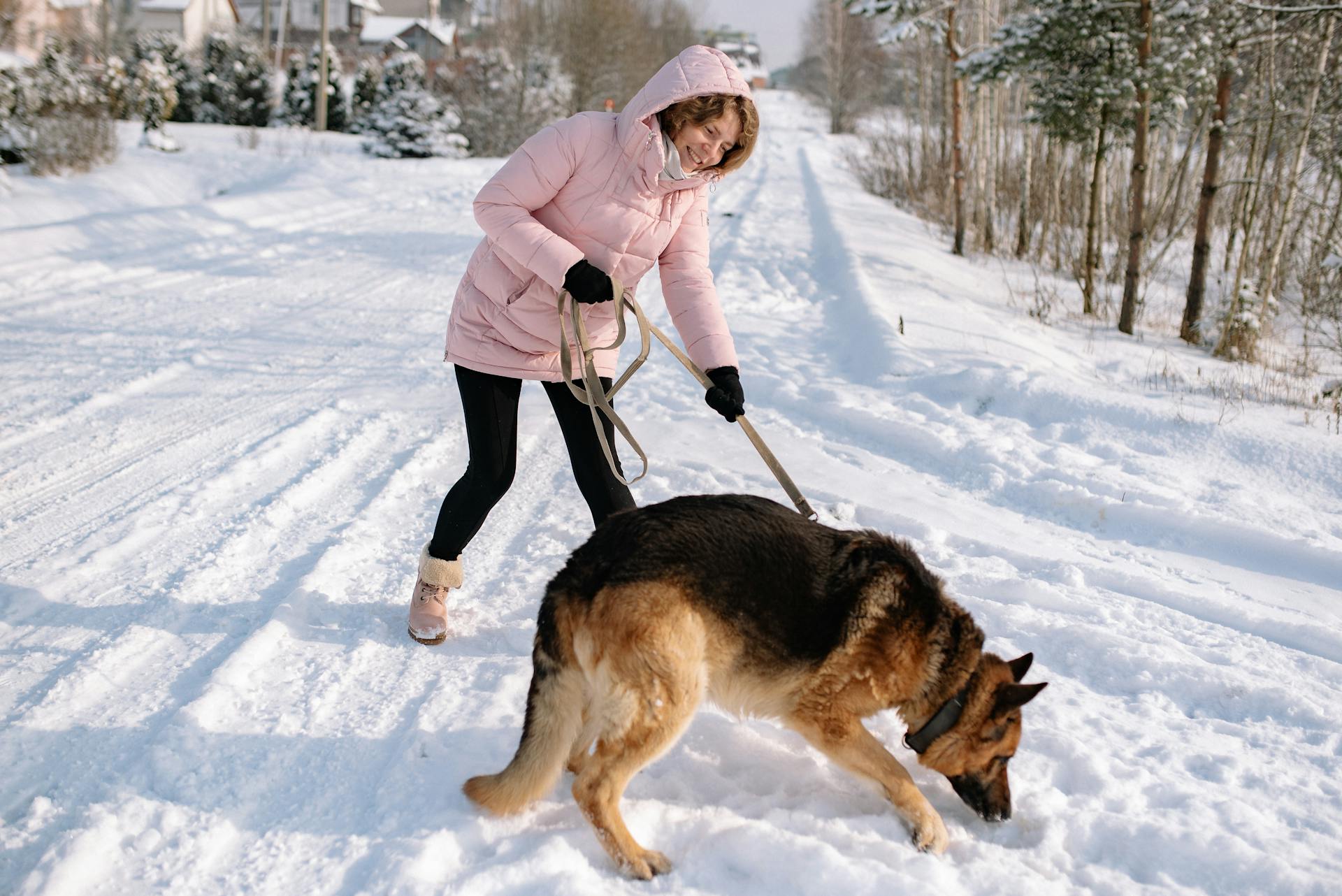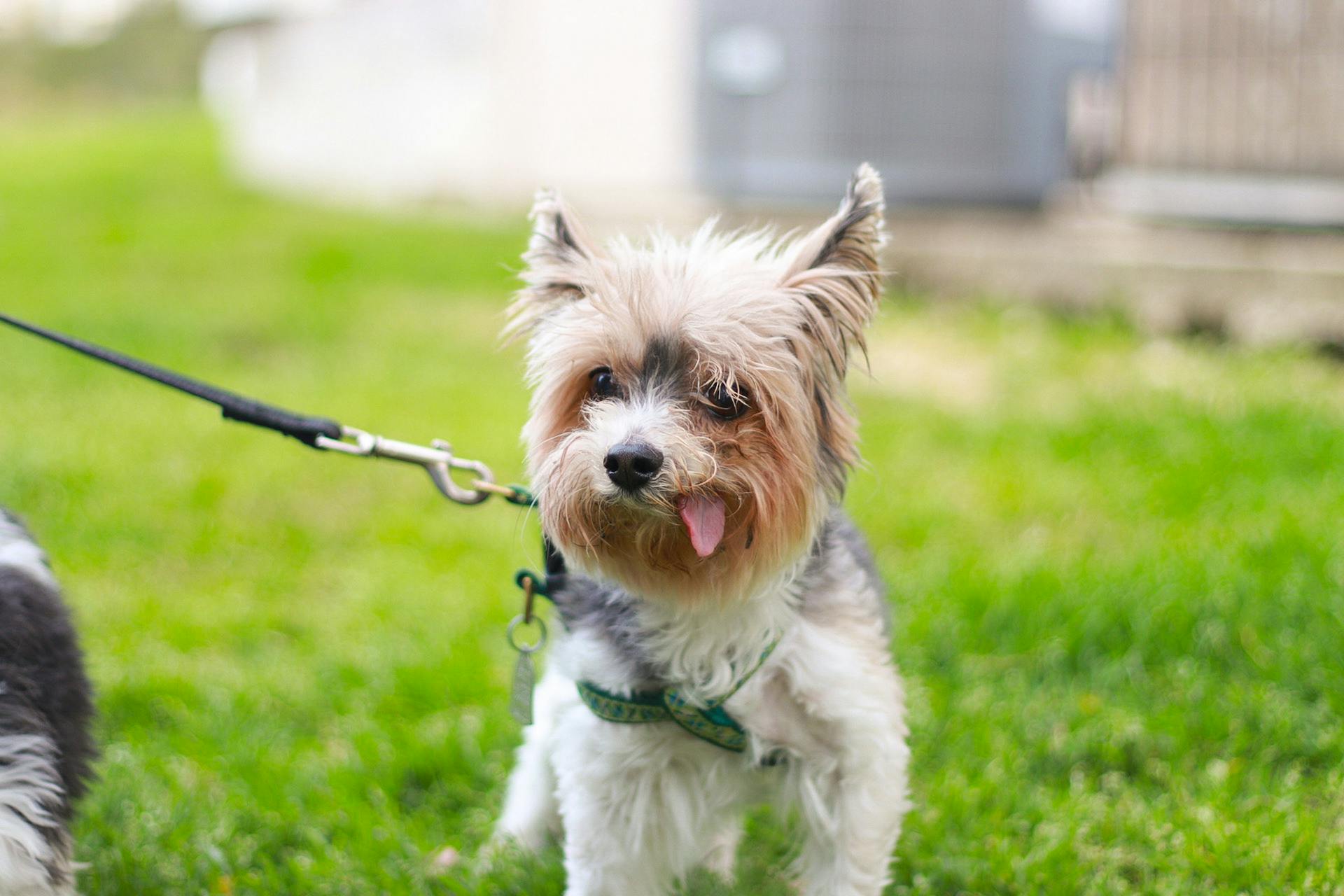
Training a dog not to pull on a leash is a common challenge many dog owners face. The main reason dogs pull is because they're not getting enough physical and mental stimulation.
Dogs that are not getting enough exercise tend to pull more on the leash, as they're trying to get to their destination quickly. In fact, studies have shown that dogs that receive regular exercise are less likely to pull on the leash.
To start leash training, it's essential to choose the right equipment, such as a harness that fits your dog comfortably. A well-fitting harness can help reduce the likelihood of your dog pulling.
By following a consistent training plan, you can teach your dog to walk by your side without pulling on the leash.
Recommended read: No Pull Dog Harness Training
Preparation and Equipment
Selecting the right equipment is crucial for enjoyable and safe walks with your dog. Proper gear can prevent pulling and ensure that walks are pleasurable for both you and your pet.
A snug-fitting harness that allows control without discomfort or restriction of movement is essential. Leashes should be kept at a manageable length, around 4 to 6 feet, to provide ample guidance without being overbearing.
Ensuring the right fit of harnesses and collars is critical to prevent escape and reduce the risk of skin irritation or injury. A well-fitted harness will make a big difference in your walks.
Experimenting with different tools, such as front-attaching harnesses, can help you find the right one for your dog. These harnesses are self-correcting and can be a game-changer for dogs that pull.
Related reading: No Treat Dog Training
Understanding and Managing Pulling
Understanding and managing pulling is crucial when training your dog not to pull on the leash. Leash pulling is a common issue dog owners encounter, often rooted in a dog's natural instincts and behavior. Dogs may pull on the leash for a variety of reasons such as excitement, desire to explore, or even to assert dominance.
Environmental stimuli heavily influence leash pulling, and a dog's surrounding can trigger their urge to pull. Consider the following factors that might contribute to leash pulling: excitement, curiosity, fear, and learning. Without proper leash training, a dog might not understand the expectations of walking calmly on a leash.
A helpful approach to reducing leash pulling involves training sessions, consistency, corrective tools, and exercise. Employ the same commands and rewards for desired behaviors, and use a chest-led harness may provide more control without discomfort for the dog. Ensure sufficient opportunities for a dog to vent energy before a structured walk.
Here are some common reasons for leash pulling:
- Excitement
- Curiosity
- Fear
- Learning
Dealing with Pulling
Leash pulling is a common issue dog owners face, often rooted in a dog's natural instincts and behavior. Dogs may pull on the leash due to excitement, desire to explore, or assert dominance. Environmental stimuli heavily influence leash pulling, with enticing scents, sights, and sounds triggering a dog's urge to pull.

A helpful approach to reducing leash pulling involves training sessions, consistency, corrective tools, and exercise. Short, frequent training moments can be more effective than long, infrequent ones. Employ the same commands and rewards for desired behaviors to ensure consistency.
Corrective tools, such as a chest-led harness, may provide more control without discomfort for the dog. However, management devices, like head halters or anti-pulling harnesses, should be used sparingly and not as a substitute for training. A good rule of thumb is to use management tools only when you're in a hurry or for the first part of your walk, then train for the last part.
If challenges continue, professional guidance from a dog trainer might be necessary to address the behavior effectively. Ensuring the dog has adequate exercise and mental stimulation outside of training sessions can alleviate over-excitement and the propensity to pull.
Reasons for Leash Pulling:
- Excitement
- Curiosity
- Fear
- Learning
Factors to Consider:
- Environmental stimuli
- Dog's natural instincts and behavior
- Training and consistency
By understanding the underlying reasons for leash pulling and implementing effective training strategies, you can help your dog learn to walk on a loose leash.
Understanding Types

Traditional leashes work well for many dogs, however, in some cases, a retractable leash may provide a sense of freedom.
A traditional leash is a good choice for most dogs, but be aware that a retractable leash can create unpredictable situations if not used attentively.
Retractable leashes can give dogs a sense of freedom, but it's essential to use them attentively to avoid potential for injury.
Check this out: Freedom K9 Dog Training
Training Techniques
Training Techniques can make a huge difference in your dog's leash manners. Positive reinforcement is a powerful method in dog training, and it's essential to provide rewards immediately after the desired action is performed.
To start, you'll need the right equipment: a collar or harness, a leash, and treats. A chest-led harness can help discourage pulling, and a 4-foot or 6-foot leash is best, as it allows for some slack.
A structured, consistent approach leads to success in leash manners. Take a step, then stop, and feed your dog a treat from your hand, in line with the seam of your pants. This will help you position the dog and teach them to walk nicely beside you.
Here's an interesting read: Dog Manners Training
To reinforce good leash manners, use a variety of rewards, such as treats, praise, or play. You can also use commands like sit, down, shake, or nose touch during a walk to keep your dog engaged.
Here are some key tips to keep in mind:
- Take small steps and reward your dog frequently.
- Stop walking if your dog pulls ahead and call them back to you.
- Gradually take more steps between each treat.
Session Timing
Training sessions should be short but frequent to maintain the dog's attention and reinforce learning. Typically, sessions of 5-10 minutes several times a day can be more effective than lengthy, less frequent sessions.
To achieve this, you can aim for several short sessions throughout the day. This sustained approach helps build the consistency needed to change behavior.
A structured, consistent approach is key to success in leash manners. This means establishing a routine and sticking to it.
By following this approach, you can curb leash pulling and develop good leash habits with your dog.
A unique perspective: Dog Training Day Care
Applying Positive Reinforcement
Positive reinforcement is a powerful tool in dog training. It's all about rewarding good behavior, rather than punishing bad behavior. This approach helps your dog understand what you want from them.
To apply positive reinforcement, you need to provide rewards immediately after the desired action is performed. This is key to making it clear to your dog what behavior has led to the positive outcome. As mentioned in Example 7, "The key is to provide the rewards immediately after the desired action is performed, making it clear to the dog what behavior has led to the positive outcome."
Rewards can come in the form of treats, praise, or play. Treats are a great way to motivate your dog, especially during training sessions. For example, Example 1 suggests using treats, praise, or play as rewards to encourage good leash manners.
Here are some tips for using positive reinforcement effectively:
- Reward your dog immediately after the desired action is performed.
- Use a variety of rewards, such as treats, praise, and play.
- Keep training sessions short and fun to maintain your dog's attention.
By following these tips and using positive reinforcement, you can help your dog learn good behavior and build a strong bond with them.
Buying a Sidewalker
You can buy a SideWalker Leash Trainer from DogWatch Training Products online or from your local dealer.
It's worth noting that the SideWalker is a great tool for training dogs to walk on a leash without pulling.
To use the SideWalker, you'll need to set it to a level that's just enough to distract your dog from the pulling behavior.
The SideWalker is safe and effective on dogs as small as 6 pounds.
If you're unsure about the size of the SideWalker for your dog, it's always a good idea to check the manufacturer's guidelines.
You can also use the SideWalker on dogs as young as 4-6 months old.
However, the effectiveness of the SideWalker may be affected by extreme temperatures, so be sure to use it in temperatures between minus 25 degrees (F) to 125 degrees (F).
Here are some general guidelines for using the SideWalker:
- For small dogs (6 pounds or less), ensure a good fit and correct contact post size.
- For dogs that continue to pull despite a good fit and correct contact post size, increase the SideWalker setting one level.
Consistency and Patience
Consistency is the cornerstone of effective dog training, and it's especially important when it comes to leash training. Consistency means applying the same rules and commands every time the dog is on a leash, which helps set clear expectations for the dog and reduces confusion.
Training a dog not to pull on a leash requires firm consistent actions and a patient mindset. The journey towards well-mannered leash behavior is gradual but achievable through methodical training and the understanding that progress takes time. Consistent training naturally leads to predictable and reliable dog behavior, and a dog that is trained consistently understands what is expected and is less likely to pull on the leash.
Importance of Patience
Patience is an invaluable trait in a trainer. It's easy to become frustrated when progress seems slow, but maintaining a calm demeanor is crucial for a dog's learning environment. Recognizing that each dog will learn at its own pace leads to a more compassionate training approach that puts the dog's well-being first.
Tracking progress methodically can also help maintain patience. This could be as simple as journaling after each walk or using a checklist to note improvements and areas where the dog still struggles. By tracking progress, trainers can see tangible results over time, reinforcing confidence in the training process.
Additional reading: Training a Deer Tracking Dog
Here are some tips for maintaining patience during training:
- Take breaks when needed to avoid burnout
- Focus on small, achievable goals
- Celebrate small victories along the way
- Remember that setbacks are a normal part of the learning process
Consistency and patience go hand-in-hand when it comes to training a dog. By being consistent in our training approach and patient with our dog's progress, we can help our furry friends learn and grow at their own pace.
If this caught your attention, see: Hand Signal for Sit Dog
Pet Safety
Pet Safety is crucial when it comes to consistency and patience in dog training. Leash corrections are a delicate matter and should be done gently but firmly.
To avoid putting too much strain on yourself, keep your dog right next to you, not out in front, when using leash corrections. The farther ahead your dog is, the more strength you'll need, and it'll be harder to correct.
A series of pulls and releases is usually necessary to help your dog understand the concept of going at your pace. Be patient and persistent, as this process can take time.
Using a training collar or harness can be a good idea, especially if your dog is large or strong. This can help you manage the leash correction process more effectively.
Explore further: Will Spaying a Dog Help with Aggression
Frequently Asked Questions
Can you teach a dog not to pull with a harness?
Yes, you can teach a dog not to pull with a harness using reward-based training methods. Consistent training and positive reinforcement can help your dog learn to walk politely beside you.
What is the #1 trick to stop your dog from pulling on the leash?
Stop walking when your dog pulls on the leash, then reward them with a treat for walking beside you. This simple technique helps your dog associate polite walking with continued movement
How long does it take to train a dog not to pull?
Training a dog not to pull can take anywhere from a week to a couple of months, depending on the dog's age and prior training. With consistent effort, you can see noticeable results and a well-behaved walking companion.
Sources
- https://www.akcpetinsurance.com/blog/loose-leash-training
- https://ferndogtraining.com/pulling-on-leash/
- https://roguepetscience.com/blogs/dog-training/how-to-stop-dog-from-pulling-on-leash
- https://www.dogwatch.com/products/electronic-dog-training-collars/sidewalker-sw-5-leash-trainer/
- https://www.animalhumanesociety.org/resource/teach-your-dog-walk-loose-leash
Featured Images: pexels.com


